In the kit, there are two eyepieces, offering magnifications of 50 and 250 times, as well as a 3-fold Barlow lens. With this kit, you can see thousands of small details on the moon, study Mars and Venus in more detail, and even see the coloured discs of Uranus and Neptune.
The finder scope is not of great quality.
The Celestron PowerSeeker 127EQ telescope has all the necessary basic functions for a novice observer. The mount tripod has an adjustable height and can be conveniently set for any height. There is also a shelf for accessories.
Newtonian Reflector
127 mm, 1000 mm
German equatorial mount with a slow-motion altitude rod
20mm (50x), 4mm (250x), 3x Barlow lens, Finderscope 5x24
“TheSky” Level 1 software included, adjustable tripod, accessory tray included
2 years
The provided accessory tray will let you keep the eyepieces and the image diagonal organised and always at hand. The all-glass optics ensure excellent image clarity. The panning handle enables hassle-free precision adjustments.
The stand is a little stiff.
Owing to its high aperture size and matching focal length, the Celestron 22065 AstroMaster 102AZ will let you reach beyond our solar system. With this telescope, you can observe Orion Nebula, Andromeda Galaxy, and more.
Refractor
102 mm, 660 mm
Manual Alt Azimuth
20mm (33x) and 10mm (66x) eyepieces Red-dot finderscope
Celestron Starry Night Software included, adjustable tripod, erect image 90° diagonal, accessory tray
2 years
Because the tripod can be rotated 360 degrees, the telescope can be moved without lifting the 'pod up. You can adjust its height from 50 to 107 centimetres, so the 'scope should fit small children and tall kids alike.
The instructions are lacking.
The Emarth 70mm Telescope prepares future astronauts, giving kids the tools they need to explore the stars and built interest in astronomy. That being said, the 'scope will also allow kids to observe terrestrial scenery.
Refractor
70 mm, 360 mm
Altazimuth mount
25mm (51x), 10mm (128x), Finderscope 5x24
2 x Map of the Moon & Star, adjustable tripod (360° rotation), erect image diagonal, pan handle, carry bag
30 days
The armoured housing will be able to handle hard use in the field. The water-resistant body will protect the optics from moisture and an occasional splash. The hard case will keep the 'scope safe even when the road gets bumpy.
The tripod feet are flimsy.
The Celestron 52223 Zoom can handle casual night sky exploration. But, as you'd presume from the images (and the 'spotting scope' part), this device will be better at aiding hunting endeavours, bird watching, and nature observation.
Refractor
60 mm, 420 mm
Altazimuth mount
14mm (60x)
Water-resistant, metal tabletop tripod, aluminium case, soft case, cleaning cloth, eyepiece cover, objective cover
Limited lifetime
The tripod is a tad wobbly.
The Aomekie F40040 packs the most thorough kit that you will find at this price point. Using the accessories that come with the scope, you can view the skies (and the surrounding nature) anytime, anywhere, from any angle.
Refractor
60 mm, 700 mm
Manual Alt Azimuth
9mm (78x), 25mm (28x), 3x Barlow lens, 5x20 finderscope
Adjustable tripod, 128° erect image diagonal, 10x eyepiece phone adapter, star target planisphere, carry bag, metal moon filter
30 days
This site is a free online resource that strives to offer helpful content and comparison features to its visitors. Please be advised that the operator of this site accepts advertising compensation from certain companies that appear on the site, and such compensation impacts the location and order in which the companies (and/or their products) are presented, and in some cases may also impact the scoring that is assigned to them. The scoring that appears on this site is determined by the site operator in its sole discretion, and should NOT be relied upon for accuracy purposes. In fact, Company/product listings on this page DO NOT imply endorsement by the site operator. Except as expressly set forth in our Terms of Use, all representations and warranties regarding the information presented on this page are disclaimed. The information which appears on this site is subject to change at any time. More info
Celestron 21049 PowerSeeker 127EQ
PERFECT FOR NOVICE USERS
Telescopes can be a little intimidating to those who haven't really used one before, especially the more powerful models that are a bit beyond a small, very basic kit. These devices are fun to use, but getting just the right adjustments to them can be difficult for novices, especially when it comes to knowing exactly what to adjust. That's why the Celestron PowerSeeker 127EQ Telescope is a great model for novices. This model was made to be easy to use for anyone, even novices, while still being powerful enough to meet the needs of more experienced telescope users.
All of the necessary basic functions required by novice users are present on this telescope, including the ability to easily adjust its position, the ability to lock it in place, and even a handy finder scope that allows for easily finding the part of the sky you want to look at. The tripod mount that comes with the telescope is adjustable to any height, making it a perfect option for parents to use with their children. The mount even includes a shelf for accessories, making this one of the more convenient models available on the market. This accessory shelf lets you keep any kinds of star charts or other helpful items at hand while you are searching the skies.

Reflector Telescope
Despite the features of this telescope that appeal to novice users, this model is also powerful enough to meet the needs of those who are more experienced with telescopes and who need more advanced capabilities. One case in point here is the magnification abilities of this telescope, which is among the best that you will find in models of its price range. Two separate eyepieces are included that provide a magnification of 50 and 250 times, respectively, as well as a 3-fold Barlow lens. These lenses give you the ability to see all of the small details that you want to make out on celestial bodies, including the moon.
Another included feature with this telescope that makes it perfect for novices is the bonus Starry Night Astronomy Software Package, which you can download to your laptop or desktop PC. This software package lets you chart the skies, helping you locate and identify thousands of different stars, planets, and other celestial bodies, turning you into an amateur astronomer in your own backyard. With all of these features coupled with the very reasonable price of this telescope, both beginners and more advanced users should find this model to be an ideal choice for their celestial adventures.
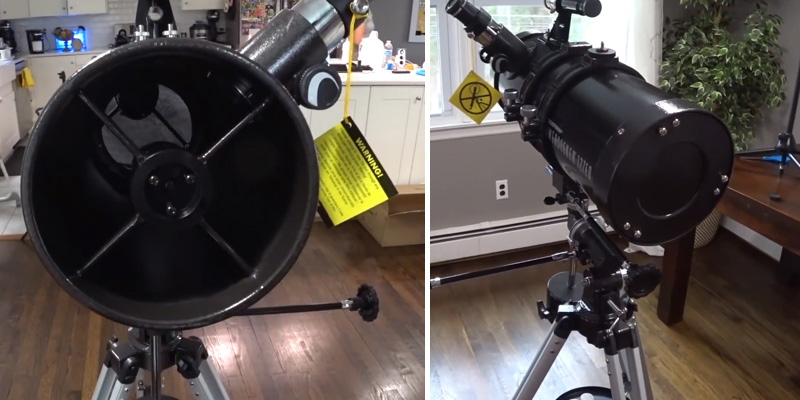
Additional Info
| Last updated price | £209.95 |
| Stock | In stock |
| ASIN | B0007UQNKY |
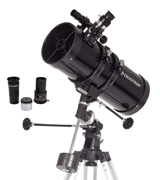
Celestron 22065 AstroMaster 102AZ
Terrestrial and Astronomical Use
The Celestron 22065 AstroMaster 102AZ lets you discover the solar system that surrounds us. With this device (to be more specific - with its hassle-free, no-tool setup), you can start observing the skies within minutes. The image that the model provides comes out bright, crisp, and sharp, enabling comfortable nighttime viewing and letting you gaze at the Moon, planets, different star clusters, and more. At the same time, equipped with erect image optics, this device will prove equally useful during the day. Set the tripod up and you can view lakes, mountain ranges, and wildlife before the sun sets.
Between the 20-millimetre (33X) and the 10-millimetre (66X) eyepieces and the above-mentioned erect image diagonal that you can tilt 90 degrees, the model accommodates terrestrial and astronomical use with matching results. Of course, the system's heart lies with the 102-millimetre achromatic lens. Incorporating coated all-glass optics, the lens delivers exceptional clarity, so you can observe even the smallest elements without noticeable detail loss.
At this price point, telescopes usually arrive with an Altazimuth mount, and the subject device fits the same mould. The difference here is that the included mount is manual. Using its panning handle, you can make easy precision adjustments, switching between viewing celestial and terrestrial objects without rotating the 'pod. Aside from making the setup a little more practical, the panning handle also lets you rely less on the stand, which is a touch stiff, a slight inconvenience that you might not even notice thanks to the said handle.
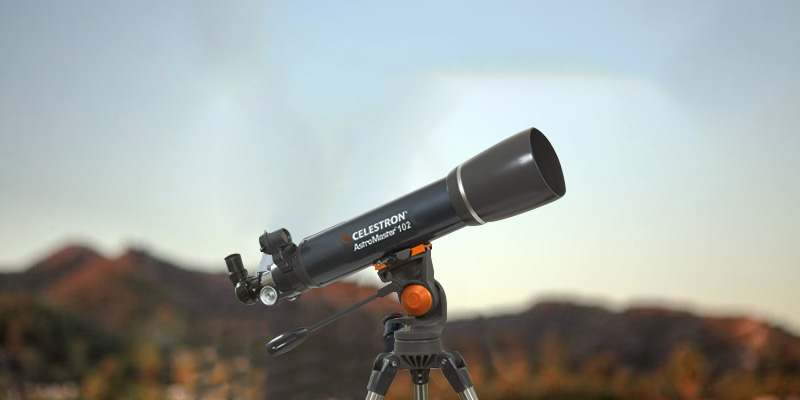
Reaching Beyond the Solar System
The telescope looks massive and, to some extent, it is. At 91 (length) x 76 (width) x 127 (length) centimetres, this is not the most petite device within this selection. Likewise, at ~9 kilogrammes, the model does not quite land among the lightest 'scopes. But with its increased size and weight also comes an increased aperture size and focal length.
Measuring 102 and 660 millimetres respectively, this device can even reach beyond the solar system, letting you explore Orion Nebula, Andromeda Galaxy, and more. Wrapping both the literal and the proverbial package is the accessory tray that's also shipped with the telescope. Using this tray, you can organise the included accessories and have them always within reach.
In short, take the Celestron 22065 AstroMaster 102AZ with you and start exploring the Earth during the day and deep space objects come nighttime.
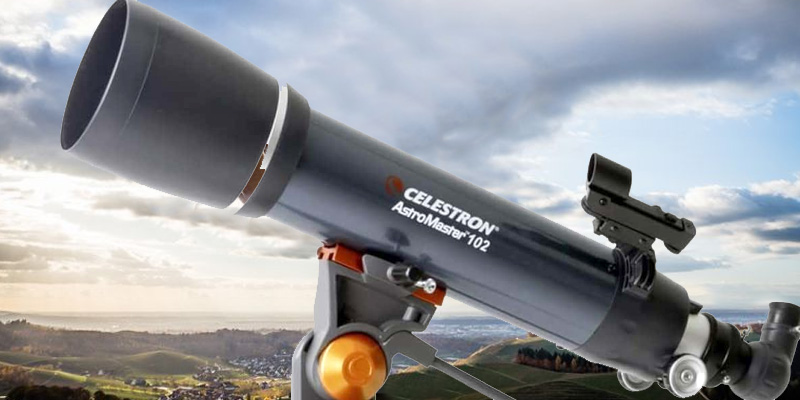
Additional Info
| Last updated price | $0.00 |
| Stock | May be out of stock |
| ASIN | B01E5DVONO |
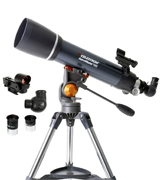
Emarth 70mm
Let Your Kid Explore
The Emarth 70mm Telescope is a small fellow. Without beating around the bush, this is a 'scope that you gift kids. Of course, grown-up beginners might appreciate the gesture as well, but its size is a little more kid-appropriate. Needless to say, this is not the most powerful or capable device we've seen yet. Having said that, with its 70-millimetre aperture, the model covers the surrounding moons, planets, and clusters without struggling. Also, matching the device's more expensive (and less newbie-oriented) competition, the telescope comes endowed with an erect image diagonal. Using this accessory, you can go from exploring vast skies to enjoying distant terrestrial scenery (mountains, lakes, wild animals, birds, flowers, you name 'em).
Apart from that, the 'scope includes two eyepieces - 25 millimetres with 51X magnification and 10 millimetres with 128X magnification. Switching between these two, you can explore faraway cosmos as much as nearby landmarks. And because these devices are seldom complete without finderscopes nowadays, the model adopts its own 5x24 'scope. Thanks to its small but helpful cross, finding stars or capturing flying birds will feel a little less challenging.
What will also feel a little less challenging is setting the telescope up. Because the provided tripod rotates 360 degrees, you can move the 'scope without lifting and moving the whole setup, which is a more comfortable alternative, suffice it to say. Furthermore, made from hard-wearing aluminium, the 'pod should not deform with time, should be able to handle occasional impact/shock damage, and shouldn't start displaying corrosion signs or forming rust patches down the road. Adding to its advantages, the tripod can be adjusted between 50 and 107 centimetres, accommodating different heights.

99% Total Light Transmission
All that's left is the telescope's performance. Besides the aperture size and focal length, what determines these devices' performance is the lens. In this case, incorporating 100% coated, all-glass, multi-layered optical components, the lens delivers clean and crisp delivers, with 99% total light transmission keeping the image bright even at night. Other than that, the 'scope comes boxed with a pan handle and a carry bag. Whilst the former lets you easily adjust the device's precision, the latter will let you transport the whole setup without worrying about losing an accessory during the trip.
In closing, future astronauts start with tools like the Emarth 70mm Telescope, so give your little one a chance as well.

| Last updated price | £63.19 |
| Stock | In stock |
| ASIN | B07DNCDPHH |
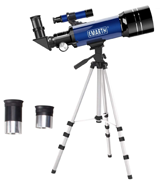
Celestron 52223
Rugged, Armoured Scope
The Celestron 52223 Zoom looks like something you can take hunting and this initial impression is not baseless. First and foremost, what we're dealing with here is a spotting scope and not a telescope. That said, with its 60-millimetre aperture and 420-millimetre focal length, the model can also accommodate occasional night sky exploration. As the package does not include multiple eyepieces, exploring the vast skies will not always be quite as comfortable as it would be with a traditional telescope, but you can make do. Again, though, this device has been designed with hunting, bird watching, nature, and wildlife observation in mind, so we would recommend taking that into account. Despite lacking in certain traditional 'scope respects, the model has its moments as well.
To start with, this device looks tough because it is tough. Its rugged, armoured housing offers excellent protection against hard use in the field. To add more, the model's body is water-resistant, so you can use it even when during rain without worrying that the optics might get damaged. Likewise, you can store the 'scope in a humid environment knowing that moisture will do nothing to its performance. Along the same lines, the finish is scratch-resistant, meaning that the telescope should be able to maintain its intense but sleek appearance in the long run.
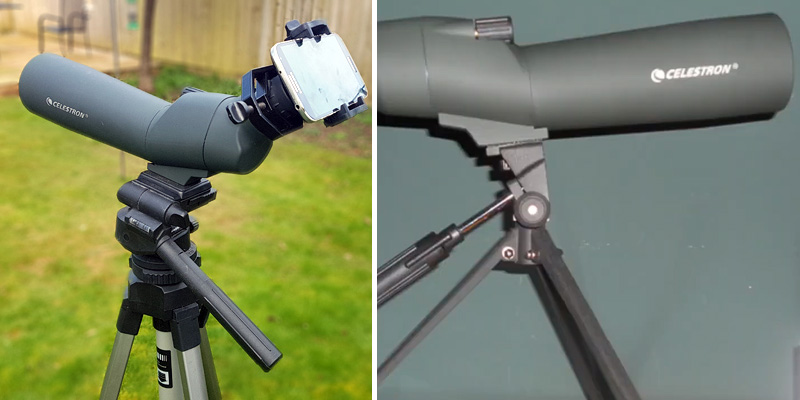
A Thorough Package
The model's rugged bodywork is established at this point. But what comes with this device is also quite sturdy in its own right. First off, made from high-tensile metal, the tabletop tripod will not bend or break as easily as its plastic counterparts. In the same vein, with its durable aluminium makeup, the hard case will let you carry the 'scope without worrying that the road might leave its mark on the device's more fragile parts (like the optics). Of course, hard cases are seldom very comfortable, so the package also includes a soft case. When you know that the road is safe and bump-free, the soft case will carry the telescope and its accessories about as well as its hard relative.
Contributing towards the same goal, the people at Celestron also send you eyepiece and objective covers. With these, you can protect these components from scratches, which is usually what plagues eyepieces and objectives even when you treat them with care. Last but not least, the same people also send you a cleaning cloth. As you can guess, the cloth will let you wipe the optics clean from dust.
Long story short, when you go hunting or observing nature, take the Celestron 52223 Zoom with you.
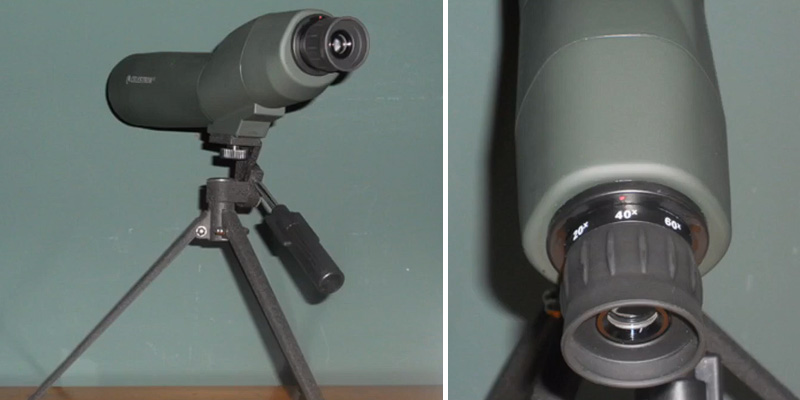
Additional Info
| Last updated price | £136.99 |
| Stock | In stock |
| ASIN | B004KMFNUG |
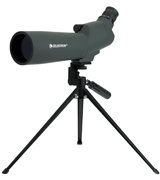
Aomekie F40040
Less Chromatic Aberration and Dispersion
The Aomekie F40040 targets beginners, not unlike the 'scope from Emarth that we have reviewed above. The biggest separation point is that this device caters to adults, whereas the Emarth model is designed for kids. But, as much as this statement holds true, most children will have no trouble using this telescope as well.
First things first, the 'scope implements a multi-coated lens. Fully coated, the lens offers excellent contrast and above-average brightness. What's more, with its multi-coating approach, the lens reduces light reflection and increases light transmission, improving image clarity and keeping the view quite crisp. Solving the same problem, the lens also minimises longitudinal chromatic aberration and dispersion so that the image you see will be as close to the real thing as it can be with beginners optics.
Sure, its 60-millimetre aperture is nothing to write home about, but the same cannot be said about the telescope's 700-millimetre focal length. Pushing 700 millimetres, its focal length delivers a wider field of view, meaning that your focus will not be as narrow as it usually is with budget 'scopes. What also sets this device apart from budget models is its 5x20 finderscope. Using it, you'll have a pretty easy time locating specific objects.

Watch the Moon
As it is always the case, the overall package sells the product as much as the telescope itself. And, in this instance, we can wholly get behind the sell. To name one, the 'scope comes supplied with a star target planisphere, so you can learn about various stars without googling 'em.
The model also comes supplied with a metal moon filter. When the moon period approaches (or is at) its full cycle, our planet's sole natural satellite gets very bright, making it hard to see its details due to the telescope's spotlight effect. With this metal filter, filtering out the moon's brightness, you can observe the moon in great detail even when at its full period.
Setting these two aside, what you receive with this package is nothing new. Needless to say, the kit includes an adjustable tripod. Though, with this tripod, the adjustment range stretches from 38 to 130 centimetres, which is quite a bit more than what you normally get with these budget tripods. In the same vein, the kit also offers an eyepiece phone adapter, letting you comfortable connect your smartphone to the 'scope.
Finally, the set provides you with a 128-degree erect image diagonal, enabling more convenient observation and making an already attractive night sky exploration kit even more enticing.

| Last updated price | $0.00 |
| Stock | May be out of stock |
| ASIN | B08GQP5B8N |
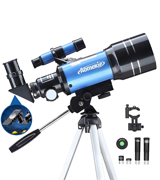
What Is a Telescope?
From Galileo Galilei to Albert Einstein to every other kid in your neighbourhood, stars never cease to fascinate people. Outer space is considered the future of the humanity. How many books and movies are created about mankind adventures out there! And while just setting out to such a journey is still a dream, we watch the Universe through the "eye" of our telescopes, the devices somewhat similar in construction to monoculars.
But telescopes, even the portable ones everyone can have at home, are so much more powerful. Today, this invention allows us to see not only a ship in the sea or a mountain far away but watch distant celestial bodies—by catching the light they emit and magnifying the image to fill the retina of our eyes. The science has gone far since the times of Copernicus, hasn't it?
If you or your kid ever dream of becoming an astronaut going for a space travel, a good overall fitness is a must. Start preparing right now with inversion tables and treadmills.
What Features to Compare
The modern telescope market has a wide selection to suit nearly every taste. The correct lens and mirror system are vital when making your choice. There are 5 mains systems to consider when choosing - a refractor, reflector, Cassegrain, Maksutov-Cassegrain, and Schmidt-Cassegrain, thus make sure to not overlook the optical surveillance system.
Refractors are usually the most affordable, portable, and the least demanding maintenance-wise optics. Needless to say, they're also usually unable to reach deep-sky objects like galaxies and nebulae, making them an excellent choice for people testing the waters but not necessarily for seasoned stargazers. Reflectors are usually all-rounders, offering above-average apertures at affordable prices. More often than not, these optics enable both planetary and deep-sky viewing. As always, the larger the aperture, the more you'll be able to see. The downside to these reflectors is usually the bulk and weight, making them less portable than refractors. Cassegrain telescopes are optically fast and, unlike Schmidt-Cassegrain optics that incorporate parabolic mirrors, these optics use spherical primary mirrors. They're not as pricey as parabolic mirrors but spherical aberration is almost always an issue with them. Schmidt-Cassegrain and Maksutov-Cassegrain systems are usually able to pack hefty aperture into the most compact tubes, making them accurate, precise, and efficient. They're free from diffraction spikes and correct spherical aberrations that plague standard Cassegrain optics. Needless to say, they are also much more expensive than the optics we've addressed above.
Next up, attention must be paid to an eyepiece and magnification. Selecting an eyepiece is a real headache for stargazers because there are lots of diverse products varying in schemes and designs. The scheme of the eyepiece determines its maximal magnification capability.
There are three main types of adjustment (mount) systems in the world of amateur telescopes, which are azimuthal, equatorial and the Dobson system. Each type of adjustment system has its own benefits and downsides. For example, an azimuthal adjustment is not excessive, inexpensive and lightweight, but is incapable of precise astronomical photography. Equatorial adjustment is more excessive and weighs more, but is more accurate when compensating for the Earth’s rotation without computers and servo-motors.
Performance opportunities and ease of use give practical advice for easy maintenance. Also, different models offer different additions and special features that simplify handling and make it more enjoyable. As an example, some of the modern telescopes have a navigation system (GPS) which helps the user to find the defined object in a matter of minutes.
Did you know?
The night sky is fascinating and, for the very same reason, the instruments that allow you to view that night sky can also be a rather fascinating subject. It may not be the most inherently complicated instrument but we bet there's a lot you don't know about it. So buckle up and settle in for these illuminating and starry telescope facts.
Sorry, Galileo
Contrary to the popular belief, Galileo did not actually invent the telescope. Despite being often credited for it, he was "merely" the first person to turn the instrument in question skyward. Being the first scientist that used a telescope to study the night sky, he was the driving force behind humanity's discovery of Jupiter's satellites, as well as the craters on the moon. Though one of the most brilliant astronomy minds in the history of mankind, he was also the very first person to point a telescope to the sun, a not-so-smart decision that may have led to his loss of sight in his later years.
Business Acumen
For the most part, we associate telescopes with astronomy, scientists, and some of the more curious minds with a deep passion for the former science. But that wasn't always the case. On the contrary, the main clientele of some of the earlier telescopes consisted mostly of merchants. These opportunistic gentlemen were buying telescopes like hotcakes and using these instruments to spot approaching trade ships. This way, they had the opportunity to beat their competitors as they were privy to the information that most of their fellow merchants didn't have access to.
Online Telescope
Nothing beats having the actual instrument at your immediate disposal. Unfortunately, that's not always an option. But there are some alternatives. For example, websites like Virtual Telescope and World Wide Telescope, among others, will provide you with a very neat opportunity to observe the night sky. Since many different websites use different telescopes that are located in different places, you'll be able to view various parts of the night sky, all from the comforts of your home.
Not Just Amateurs
The convenience of commanding a robotic observatory without actually leaving the premises of your home is so alluring that even the majority of professional astronomers work this way too. While it may seem less romantic, there are very few astronomers these days that actually look through an eyepiece instead of using a computer to remotely operate the telescope.
Mind-Boggling Numbers
Some of the most powerful telescopes out there have the ability to see about 13 billion light-years away. It is hard to wrap your head around these kinds of numbers, isn't it? Well, it gets even more unfathomable. Most astronomers believe the aforementioned number to be the approximate age of the universe. So, looking out that far is actually akin to looking back in time. And if that isn't spooky, we don't know what is.
Shying Away from the Camera
The Hubble Space Telescope has done a lot for us. But it hasn't been able to photograph Earth and Mercury. With the former, the problem is that the telescope is too close to the planet to take a clear picture. And Mercury' issue is that the said planet is so close to the sun that it's intense reflected light would end up damaging Hubble’s instruments.
FAQ:
Q: What are these f/5, f/10 numbers?
A: They are called the focal ratio or also the "speed" of the telescope. Focal ratio is calculated by dividing the focal length by the aperture and in simple words, it shows how wide and bright the image you see will be. Faster focal ratios (those with lower numbers) have wider field and lower magnification, good for those users who are into deep space observation. Slower ratios are good to watch the Moon, planets and other big or relatively close objects.
Q: Do I need a Barlow lens?
A: That is up to you to decide. Barlow lenses magnify the image of the eyepieces, so, let's say, instead of buying three additional eyepieces with double the magnification of the three you already have, you can buy a single 2x Barlow lens and use it with each. Actually, using a Barlow will offer you a better quality image with less aberration.
Q: Is more magnification always better?
A: Not always, it normally depends on what you look at. When you have higher magnification, you simultaneously lose in the field of view and in brightness. Consequently, if the object you look at is already faint, high magnification will not help. To see faint objects clearer and to make them appear brighter, you need higher aperture. Also, at the higher aperture, you can also add magnification.
Q: Do I need all these many eyepieces?
A: Different eyepieces are good to observe different objects, so if you are buying a telescope for a single particular type of objects you might not need additional eyepieces but for anyone interested in astronomy in general, the more eyepieces usually the better.
Q: Reflector vs. refractor, which should I choose?
A: Again, this is subjective to your goals. Refractors provide more contrasting pictures than reflectors but a refractor with a big aperture for observing deep space would be extremely bulky and will cost an immense amount of money so they are usually better for planetary, lunar observation, and to watch really bright binary stars and nebulae. Reflectors have bigger apertures, thus they gather more light and allow you to see farther into space clearly.
Sources:
1. Lauren Cox Who Invented the Telescope? Space.com. July 13, 2013.
2. Craig Freudenrich, PhD. How Telescopes Work, HowStuffWorks.
3. Daniel Schwartz 10 Things To Prepare You For Space Travel, Flight Centre. April 20, 2015.
4. BUYING A TELESCOPE FAQ, The University of Toledo.
5. Telescope, Wikipedia.
6. Christopher Witt Telescope Buying Guide, B&H Explora.
7. Ryan Wick Beginner’s Telescope Buying Guide, IFL Science.



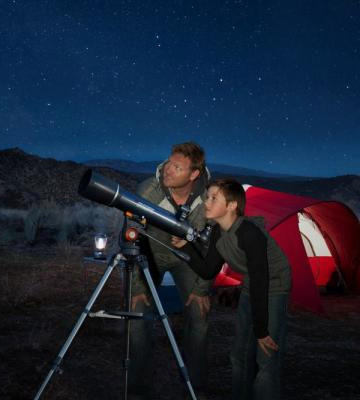

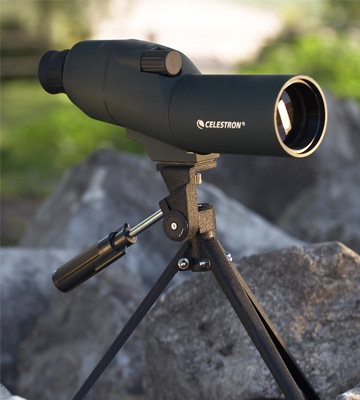
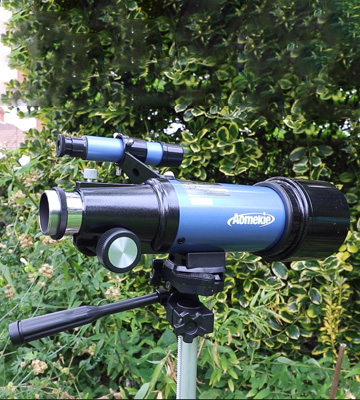

Your comment was successfully sent
Error! Please try again later